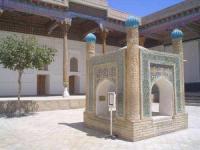You are here
Baghauddin Nakshbandi.

Sightseeing tours in Uzbekistan
“For everything in this journey of life we are on, there is a right wing and a left wing: for the wing of love there is anger; for the wing of destiny there is fear; for the wing of pain there is healing; for the wing of hurt there is forgiveness; for the wing of pride there is humility; for the wing of giving there is taking; for the wing of tears there is joy; for the wing of rejection there is acceptance; for the wing of judgment there is grace; for the wing of honor there is shame; for the wing of letting go there is the wing of keeping. We can only fly with two wings and two wings can only stay in the air if there is a balance. Two beautiful wings is perfection. There is a generation of people who idealize perfection as the existence of only one of these wings every time. But I see that a bird with one wing is imperfect. An angel with one wing is imperfect. A butterfly with one wing is dead. So this generation of people strive to always cut off the other wing in the hopes of embodying their ideal of perfection, and in doing so, have created a crippled race”
C. JoyBell C.
Tourist groups in Uzbekistan.
Baghauddin Naqshband or Baha ad-Din Muhammad al-Bukhari, was also known as Shahi Naqshbandi and Khodja Buzurg (1318 - 1389) - a teacher of Sufism, is considered the founder of the Sufi Order of Naqshbandi.
Baghauddin Naqshband was born in 1318 in the family of an artisan near Bukhara, in the village of Kasri-Hinduvan. The name Baghauddin means "decoration of religion." Unfortunately, there are very few biographical data on Bahauddin in history.
Since he forbade his students to write down acts, most of the manuscripts were created after his death. Bahauddin Naqshband took over his interest in Sufism from his grandfather. The first teacher of Baghauddin, Sheikh Muhammad Babayi Simasi, sent him to Sheikh Amir Sayyid Kulal, who initiated him into the Dervish society Hojagan.
Nakshbandi preached simplicity and unpretentiousness, rejected asceticism and solitude, was a supporter of worldly life, which forms the personality of a person, opposed rites and ostentatious piety, ostentatious forty-day fasting, loud zikr and vagrancy.
Studying and comprehending Sufi wisdom, Bahauddin did not depart from everyday affairs. He did not accept the wandering way of life of the dervishes who existed for alms. He weaved a magnificent silk fabric "Kamha" and was a skilled metal carver, so he got the nickname Naqshband, which means "metal carver."
Following his example, the followers of Sufism began to unite in the community and earn money for a living, and stopped wandering. One day, during prayer to Bakhauddin, Saint Khakim-Ata appeared and informed him that he would receive further training from a certain mentor from the dervishes.
Bahauddin decided to find this dervish, and soon he managed to find him. Mentor Baghauddin was called Khalil, who six years later became the ruler of the District. Bahauddin stayed at the court of Sultan Khalil and was able to use the rich palace library, paying particular attention to the manuscripts of Muslim theologians.
But soon Baghauddin left the palace of the Sultan and stopped in the village of Rivatun near Bukhara. Having lived in this village for about three years, Bahauddin decided to go to Mecca and Medina, to the tomb of the Prophet Mohammed.
But his path lay through many different cities. Only three years later, Baghauddin returned to his native Bukhara. He honored spiritual purity, unpretentiousness, turned away from luxury and charity. According to his teachings, a true Sufi is obliged to follow the sunnah and all the precepts of the Shari'a.
Bahaudduddin established 11 rules of meditation and developed a certain method of breathing. At first, the citizens of Naqshbandia entered the society, but it soon became known among the nomads, which contributed to the spread of Islam throughout the territory of Central Asia.
Subsequently, the Naqshbandia society began to spread its activities in Ottoman Turkey, India and the Muslim Volga region. The distinctive emblem of this society was the heart, which bore the word "Allah". Over time, the authority of the Nakshbandi grew, thanks to the fact that Baghauddin, in the name of protecting the interests of ordinary people, normalized the interaction of the Order of Nakshbandi with secular authorities.
As a result, the political activity of the fraternity has increased. The opinion of the sheikh of the Nakshband order became authoritative among the rulers of the most powerful states, including the state of Amir Timur, who at that time began his political activities.
Throughout his life, Baghauddin did good deeds, multiplying the importance of religion in society. Not only by prayers, but by his every action, Baghauddin Naqshband justified his chosen sacred path. At the core of his spiritual life was adherence to Islam and respect for the covenants of the Prophet Mohammed.
Bukhara was called the “Islam Dome in the East” due to the high holiness of Baghauddin Naqshband. After his death, Baghauddin Naqshbanda was canonized, and they recognized him as the patron saint of Bukhara, where his whole life passed.
In 1544 a mausoleum was erected over the tomb of Baghauddin Naqshband. Central Asian Muslims considered this mausoleum to be a place of pilgrimage, three visits to which equated to one visit to Mecca and Medina.
Enlightener:
Saga Publishing House "Great People of Central Asia". 2011.






